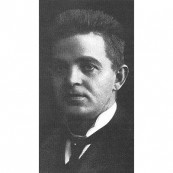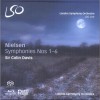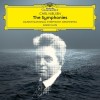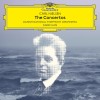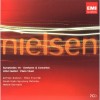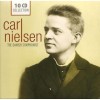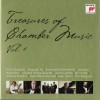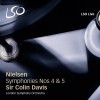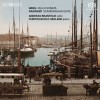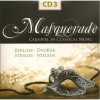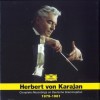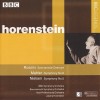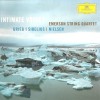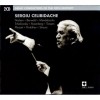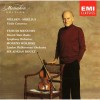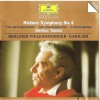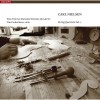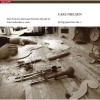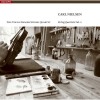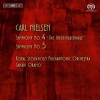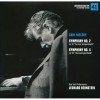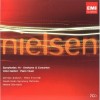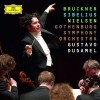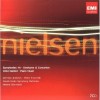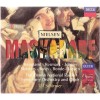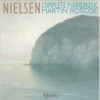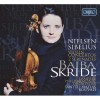Composers
Karl August Nielsen (Danish pronunciation: [kʰɑːl ˈnelsn̩]), (9 June 1865 – 3 October 1931), widely recognised as Denmark's greatest composer, was also a conductor and a violinist. Brought up by poor but musically talented parents on the island of Funen, he demonstrated his musical abilities at an early age. While it was some time before his works were fully appreciated, even in his home country, Nielsen has now firmly entered the international repertoire. Especially in Europe and the United States, Nielsen's music is ever more frequently performed, with interest growing in other countries as well. Carl Nielsen is especially admired for his six symphonies, his Wind Quintet and his concertos for violin, flute and clarinet. In Denmark, his opera Maskarade and a considerable number of his songs have become an integral part of the national heritage. While his early music was inspired by composers such as Brahms and Grieg, he soon started to develop his own style, first experimenting with progressive tonality and later diverging even more radically from the standards of composition still common at the time. For many years, he appeared on the Danish hundred-kroner banknote.
Nielsen was the seventh of 12 children in a poor peasant family in Nørre Lyndelse near Sortelung south of Odense on the Danish island of Funen. His father, Niels Jørgensen, was a house painter and amateur musician who, with his abilities as a fiddler and cornet player, was in strong demand for local celebrations. All the children bore the surname Nielsen despite regulations by the Ministry of Church Affairs. Nielsen's own description of his childhood in his autobiography Min Fynske Barndom (My Childhood in Funen) written in his later life appears to be a rather over-romanticised account. His mother whom he recalls singing folk songs during his childhood was in fact the daughter of a well-to-do family of sea captains and his uncle was a composer and performer of popular music. Nevertheless, Nielsen's own account of his introduction to music where he tells us: "I had heard music before, heard father play the violin and cornet, heard mother singing, and, when in bed with the measles, I had tried myself out on the little violin" is probably authentic.
Nielsen learned the violin and piano as a child and wrote his earliest compositions at the age of eight or nine: a lullaby, now lost, and a polka which the composer notated in his autobiography. However, his parents apparently did not believe he had any future as a musician as he was apprenticed to a shopkeeper from a nearby village at age 14. By midsummer the shopkeeper had gone bankrupt and Carl had to go home to his parents. He also learned how to play brass instruments, which led to a job as a bugler and alto trombonist in the 16th Battalion at nearby Odense that opened up around the time his apprenticeship ended. Carl took up his new positions in the 16th Battalion on the first of November 1879.
While Nielsen did not give up the violin during his time in the military, for his first two years he usually only played it when he went home to appear at dances with his father. In 1881, he began to take his violin playing more seriously and began to take private lessons from Carl Larsen, who was the sexton at Odense Cathedral. It is not known how much Carl Nielsen composed during his time in the military, but from his autobiography, it can be deduced that he wrote some trios and quartets for brass instruments, and that he had difficulty in coming to terms with the fact that brass instruments were tuned in different keys. One of his overseers, Klaus Berntsen, introduced him to Niels Gade, who was director of the Royal Conservatory. Nielsen was well received by Gade, and made sure that he could be released at a short notice from the military band. In January 1884, he went to Copenhagen for further studies at the conservatory.
He studied at the Royal Conservatory in Copenhagen from the beginning of 1884 until December 1886. Though not an outstanding student there and composing little, he progressed well in violin under Valdemar Tofte and received a solid grounding in music theory from Orla Rosenhoff, who would remain a valued adviser during Nielsen's early years as a professional composer. He also studied composition under Niels Gade, Denmark's revered composer, whom he liked as a friend but not for his music. Contacts with fellow students and cultured families in Copenhagen, some of whom would become lifelong friends, would become equally important. The patchy education resulting from his country background left Nielsen insatiably curious about the arts, philosophy and aesthetics. But, as David Fanning writes, it also left him "with a highly personal, common man's point of view on those subjects".
By September 1889, only three years after graduating from the conservatory, Nielsen had progressed well enough on the violin to gain a position with the second violins in the prestigious Royal Danish Orchestra which played at Copenhagen's Royal Theater. This position would sometimes cause Nielsen considerable frustration but he continued to play there until 1905. In between graduation and attaining this position, he gave violin lessons, made a modest income as a teacher and enjoyed continued support from patrons. Some of Nielsen's string chamber works were performed at this time, including a Quartet in F which he considered his official debut as a professional composer. However, the greatest impression was made by the Suite for Strings, which was performed at Tivoli Hall on 8 September 1888. Nielsen would designate this work his Opus 1.
After less than a year at the Royal Theater, Nielsen won a scholarship of 1,800 kroner (£90[a]), giving him the means to spend several months traveling in Europe. During this time he discovered and abandoned Richard Wagner's music dramas, heard many of Europe's leading orchestras and soloists and sharpened his opinions on both music and the visual arts. While revering the music of Bach and Mozart, he remained ambivalent about much 19th century music. In Paris, he met the Danish sculptor Anne Marie Brodersen, who was also traveling on a scholarship. They toured Italy together, marrying in the English Church of St Mark's in Florence on 10 May 1891 before returning to Denmark.
"As well as being a love match," Fanning writes, "it was also a meeting of minds. Anne Marie was a gifted artist.... She was also a strong-willed and modern-minded woman, determined to forge her own career." This determination would strain the Nielsens' marriage, as Anne Marie would spend months on location during the 1890s and 1900s, leaving Carl to raise their three young children in addition to composing and coping with his duties at the Royal Theater. While Carl suggested divorce in March 1905, the Nielsens remained married for the remainder of the composer's life. Carl sublimated his anger and frustration over his marriage in a number of musical works, most notably between 1897 and 1904, a period to which he sometimes referred as his "psychological" period. Fanning writes, "At this time his interest in the driving forces behind human personality crystallized in the opera Saul og David and the Second Symphony ("De fire temperamenter") and the cantatas Hymnus amoris and Søvnen.
At first, he did not gain enough recognition for his works to be able to support himself. During the concert which saw the premiere of his first symphony on 14 March 1894 conducted by Johan Svendsen, Nielsen played in the second violin section. However, the symphony was a great success when played in Berlin in 1896, contributing significantly to his reputation. Nielsen became increasingly in demand to write incidental music for the theater and cantatas to mark special occasions, both of which provided a welcome source of additional income. "A reciprocal relationship grew up between his programmatic and symphonic works," Fanning writes; "sometimes he would find stageworthy ideas in his supposedly pure orchestral music; sometimes a text or scenario forced him to invent vivid musical imagery which he could later turn to more abstract use."
Beginning in 1901, Nielsen received a modest state pension—800 kroner at first, growing to 7,500 kroner by 1927—to augment his violinist's salary. This allowed him to stop taking private pupils and left him more time to compose. From 1903, he also had an annual retainer from his principal publisher, Wilhelm Hansen Edition. Between 1905 and 1914 he served as second conductor at the Royal Theatre. From 1914 to 1926, he conducted the orchestra of Musikforeningen or the Music Society. In 1916, he took a post teaching at the Royal Danish Academy of Music in Copenhagen, and continued to work there until his death, in his last year as director of the institute.
The strain of dual careers and constant separation from his wife led Nielsen to more than one extra-marital affair. When the last one came to light, between Nielsen and his children's governess, the result was an eight-year breach in his marriage. During much of this time Carl and Anne Marie lived apart. The period led to a creative crisis for Nielsen, bringing about a powerful reappraisal of himself as a composer. This, along with World War I and professional developments in his life, would strongly influence his Fourth and Fifth Symphonies, arguably his greatest works.
For his son-in-law, the Hungarian violinist Dr. Emil Telmányi, Nielsen wrote his Violin Concerto, Op. 33 (1911).
After suffering a serious heart attack in 1925, Nielsen was forced to curtail much of his activity, although he continued to compose until his death. In 1927, he wrote My Childhood on Funen (Min Fynske Barndom), a delightful memoir of his childhood . He also produced a short book of essays entitled Living Music (1925). Both have been translated into English, and Min Fynske Barndom was made into a docu-drama in 1994. Carl Nielsen died in Copenhagen in 1931 and is buried in Vestre Cemetery.
Recently Added
| Country: | Denmark |
| Period: | Romantique |
Biography
Karl August Nielsen (Danish pronunciation: [kʰɑːl ˈnelsn̩]), (9 June 1865 – 3 October 1931), widely recognised as Denmark's greatest composer, was also a conductor and a violinist. Brought up by poor but musically talented parents on the island of Funen, he demonstrated his musical abilities at an early age. While it was some time before his works were fully appreciated, even in his home country, Nielsen has now firmly entered the international repertoire. Especially in Europe and the United States, Nielsen's music is ever more frequently performed, with interest growing in other countries as well. Carl Nielsen is especially admired for his six symphonies, his Wind Quintet and his concertos for violin, flute and clarinet. In Denmark, his opera Maskarade and a considerable number of his songs have become an integral part of the national heritage. While his early music was inspired by composers such as Brahms and Grieg, he soon started to develop his own style, first experimenting with progressive tonality and later diverging even more radically from the standards of composition still common at the time. For many years, he appeared on the Danish hundred-kroner banknote.
Nielsen was the seventh of 12 children in a poor peasant family in Nørre Lyndelse near Sortelung south of Odense on the Danish island of Funen. His father, Niels Jørgensen, was a house painter and amateur musician who, with his abilities as a fiddler and cornet player, was in strong demand for local celebrations. All the children bore the surname Nielsen despite regulations by the Ministry of Church Affairs. Nielsen's own description of his childhood in his autobiography Min Fynske Barndom (My Childhood in Funen) written in his later life appears to be a rather over-romanticised account. His mother whom he recalls singing folk songs during his childhood was in fact the daughter of a well-to-do family of sea captains and his uncle was a composer and performer of popular music. Nevertheless, Nielsen's own account of his introduction to music where he tells us: "I had heard music before, heard father play the violin and cornet, heard mother singing, and, when in bed with the measles, I had tried myself out on the little violin" is probably authentic.
Nielsen learned the violin and piano as a child and wrote his earliest compositions at the age of eight or nine: a lullaby, now lost, and a polka which the composer notated in his autobiography. However, his parents apparently did not believe he had any future as a musician as he was apprenticed to a shopkeeper from a nearby village at age 14. By midsummer the shopkeeper had gone bankrupt and Carl had to go home to his parents. He also learned how to play brass instruments, which led to a job as a bugler and alto trombonist in the 16th Battalion at nearby Odense that opened up around the time his apprenticeship ended. Carl took up his new positions in the 16th Battalion on the first of November 1879.
While Nielsen did not give up the violin during his time in the military, for his first two years he usually only played it when he went home to appear at dances with his father. In 1881, he began to take his violin playing more seriously and began to take private lessons from Carl Larsen, who was the sexton at Odense Cathedral. It is not known how much Carl Nielsen composed during his time in the military, but from his autobiography, it can be deduced that he wrote some trios and quartets for brass instruments, and that he had difficulty in coming to terms with the fact that brass instruments were tuned in different keys. One of his overseers, Klaus Berntsen, introduced him to Niels Gade, who was director of the Royal Conservatory. Nielsen was well received by Gade, and made sure that he could be released at a short notice from the military band. In January 1884, he went to Copenhagen for further studies at the conservatory.
He studied at the Royal Conservatory in Copenhagen from the beginning of 1884 until December 1886. Though not an outstanding student there and composing little, he progressed well in violin under Valdemar Tofte and received a solid grounding in music theory from Orla Rosenhoff, who would remain a valued adviser during Nielsen's early years as a professional composer. He also studied composition under Niels Gade, Denmark's revered composer, whom he liked as a friend but not for his music. Contacts with fellow students and cultured families in Copenhagen, some of whom would become lifelong friends, would become equally important. The patchy education resulting from his country background left Nielsen insatiably curious about the arts, philosophy and aesthetics. But, as David Fanning writes, it also left him "with a highly personal, common man's point of view on those subjects".
By September 1889, only three years after graduating from the conservatory, Nielsen had progressed well enough on the violin to gain a position with the second violins in the prestigious Royal Danish Orchestra which played at Copenhagen's Royal Theater. This position would sometimes cause Nielsen considerable frustration but he continued to play there until 1905. In between graduation and attaining this position, he gave violin lessons, made a modest income as a teacher and enjoyed continued support from patrons. Some of Nielsen's string chamber works were performed at this time, including a Quartet in F which he considered his official debut as a professional composer. However, the greatest impression was made by the Suite for Strings, which was performed at Tivoli Hall on 8 September 1888. Nielsen would designate this work his Opus 1.
After less than a year at the Royal Theater, Nielsen won a scholarship of 1,800 kroner (£90[a]), giving him the means to spend several months traveling in Europe. During this time he discovered and abandoned Richard Wagner's music dramas, heard many of Europe's leading orchestras and soloists and sharpened his opinions on both music and the visual arts. While revering the music of Bach and Mozart, he remained ambivalent about much 19th century music. In Paris, he met the Danish sculptor Anne Marie Brodersen, who was also traveling on a scholarship. They toured Italy together, marrying in the English Church of St Mark's in Florence on 10 May 1891 before returning to Denmark.
"As well as being a love match," Fanning writes, "it was also a meeting of minds. Anne Marie was a gifted artist.... She was also a strong-willed and modern-minded woman, determined to forge her own career." This determination would strain the Nielsens' marriage, as Anne Marie would spend months on location during the 1890s and 1900s, leaving Carl to raise their three young children in addition to composing and coping with his duties at the Royal Theater. While Carl suggested divorce in March 1905, the Nielsens remained married for the remainder of the composer's life. Carl sublimated his anger and frustration over his marriage in a number of musical works, most notably between 1897 and 1904, a period to which he sometimes referred as his "psychological" period. Fanning writes, "At this time his interest in the driving forces behind human personality crystallized in the opera Saul og David and the Second Symphony ("De fire temperamenter") and the cantatas Hymnus amoris and Søvnen.
At first, he did not gain enough recognition for his works to be able to support himself. During the concert which saw the premiere of his first symphony on 14 March 1894 conducted by Johan Svendsen, Nielsen played in the second violin section. However, the symphony was a great success when played in Berlin in 1896, contributing significantly to his reputation. Nielsen became increasingly in demand to write incidental music for the theater and cantatas to mark special occasions, both of which provided a welcome source of additional income. "A reciprocal relationship grew up between his programmatic and symphonic works," Fanning writes; "sometimes he would find stageworthy ideas in his supposedly pure orchestral music; sometimes a text or scenario forced him to invent vivid musical imagery which he could later turn to more abstract use."
Beginning in 1901, Nielsen received a modest state pension—800 kroner at first, growing to 7,500 kroner by 1927—to augment his violinist's salary. This allowed him to stop taking private pupils and left him more time to compose. From 1903, he also had an annual retainer from his principal publisher, Wilhelm Hansen Edition. Between 1905 and 1914 he served as second conductor at the Royal Theatre. From 1914 to 1926, he conducted the orchestra of Musikforeningen or the Music Society. In 1916, he took a post teaching at the Royal Danish Academy of Music in Copenhagen, and continued to work there until his death, in his last year as director of the institute.
The strain of dual careers and constant separation from his wife led Nielsen to more than one extra-marital affair. When the last one came to light, between Nielsen and his children's governess, the result was an eight-year breach in his marriage. During much of this time Carl and Anne Marie lived apart. The period led to a creative crisis for Nielsen, bringing about a powerful reappraisal of himself as a composer. This, along with World War I and professional developments in his life, would strongly influence his Fourth and Fifth Symphonies, arguably his greatest works.
For his son-in-law, the Hungarian violinist Dr. Emil Telmányi, Nielsen wrote his Violin Concerto, Op. 33 (1911).
After suffering a serious heart attack in 1925, Nielsen was forced to curtail much of his activity, although he continued to compose until his death. In 1927, he wrote My Childhood on Funen (Min Fynske Barndom), a delightful memoir of his childhood . He also produced a short book of essays entitled Living Music (1925). Both have been translated into English, and Min Fynske Barndom was made into a docu-drama in 1994. Carl Nielsen died in Copenhagen in 1931 and is buried in Vestre Cemetery.
